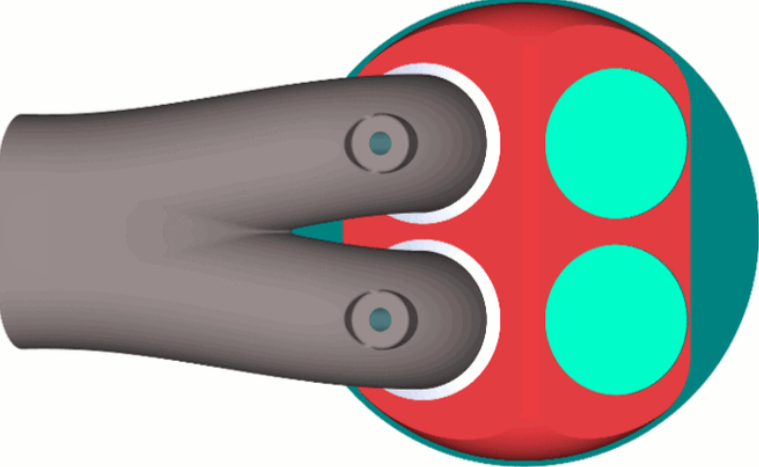caeses feture外飘角
软件: caeses
1. Definition of Outward Flare Angle in Ship Design
The outward flare angle refers to the angular measurement of the ship's hull side or bow section expanding outward from the vertical plane. It is a critical parameter in ship geometry that quantifies how much the hull widens horizontally above the waterline, directly influencing hydrodynamic performance and seakeeping. In technical terms, it is the angle formed between the hull side surface and a vertical reference plane (e.g., the centerline of the ship) at a given waterline height.
2. Key Role in Ship Hydrodynamics and Structural Performance
The outward flare angle is integral to optimizing a ship’s interaction with water. Its primary functions include:
- Reducing Wave Slamming: By widening the hull above the waterline, the flare angle helps deflect incoming waves, decreasing the impact of wave slamming on the deck and superstructure. This minimizes structural damage and improves crew comfort.
- Enhancing Seakeeping: A well-designed flare angle improves a ship’s ability to cut through waves, reducing rolling and pitching motions in rough seas. This is particularly important for passenger ships and offshore vessels.

- Balancing Stability and Resistance: The flare angle must be carefully tuned to avoid excessive drag (which reduces speed) while maintaining adequate stability. Too much flare can increase resistance, while too little may compromise seakeeping.
3. Measurement of Outward Flare Angle in CAESES
CAESES, a leading software for ship parametric modeling, provides automated tools to calculate the outward flare angle at specific waterline heights. The process involves:
- Importing Geometry: Loading the ship’s hull model (e.g., a KCS hull) in IGES format and converting it to a Brep (Boundary Representation) surface for analysis.
- Creating Reference Lines: Generating a vertical reference line (e.g., at X=30m) along the ship’s centerline, with a height range covering the target waterline (e.g., 0–10.8m for the design waterline).
- Projecting Curves: Using the "Project and Trim" function to project the reference line onto the hull surface, creating a projection curve that follows the hull’s outward flare.
4. Application in Ship Design Optimization
The outward flare angle is a key input in ship design optimization workflows. For example, when optimizing the KCS hull using CAESES and STAR-CCM+, the flare angle is adjusted alongside other parameters (e.g., bow shape, parallel midbody length) to minimize total resistance. CAESES’ parametric modeling capabilities allow designers to automatically update the flare angle and other features, generating multiple design variants for CFD analysis. This iterative process helps identify the optimal flare angle that balances resistance, seakeeping, and structural performance.
5. Integration with Other Ship Parameters
The outward flare angle is closely linked to other hull parameters, such as:
- Breadth and Depth: Wider ships typically have larger flare angles to maintain hydrodynamic efficiency.
- Bow Shape: Ships with bulbous bows often have more pronounced flare to reduce wave resistance.
- Parallel Midbody: The length of the parallel midbody (the section between the bow and stern where the hull width is constant) affects how the flare angle transitions along the hull.
By integrating the outward flare angle with these parameters, designers can create hull forms that meet specific performance requirements, such as high speed, low resistance, or excellent seakeeping.
The outward flare angle refers to the angular measurement of the ship's hull side or bow section expanding outward from the vertical plane. It is a critical parameter in ship geometry that quantifies how much the hull widens horizontally above the waterline, directly influencing hydrodynamic performance and seakeeping. In technical terms, it is the angle formed between the hull side surface and a vertical reference plane (e.g., the centerline of the ship) at a given waterline height.
2. Key Role in Ship Hydrodynamics and Structural Performance
The outward flare angle is integral to optimizing a ship’s interaction with water. Its primary functions include:
- Reducing Wave Slamming: By widening the hull above the waterline, the flare angle helps deflect incoming waves, decreasing the impact of wave slamming on the deck and superstructure. This minimizes structural damage and improves crew comfort.
- Enhancing Seakeeping: A well-designed flare angle improves a ship’s ability to cut through waves, reducing rolling and pitching motions in rough seas. This is particularly important for passenger ships and offshore vessels.

- Balancing Stability and Resistance: The flare angle must be carefully tuned to avoid excessive drag (which reduces speed) while maintaining adequate stability. Too much flare can increase resistance, while too little may compromise seakeeping.
3. Measurement of Outward Flare Angle in CAESES
CAESES, a leading software for ship parametric modeling, provides automated tools to calculate the outward flare angle at specific waterline heights. The process involves:
- Importing Geometry: Loading the ship’s hull model (e.g., a KCS hull) in IGES format and converting it to a Brep (Boundary Representation) surface for analysis.
- Creating Reference Lines: Generating a vertical reference line (e.g., at X=30m) along the ship’s centerline, with a height range covering the target waterline (e.g., 0–10.8m for the design waterline).
- Projecting Curves: Using the "Project and Trim" function to project the reference line onto the hull surface, creating a projection curve that follows the hull’s outward flare.
4. Application in Ship Design Optimization
The outward flare angle is a key input in ship design optimization workflows. For example, when optimizing the KCS hull using CAESES and STAR-CCM+, the flare angle is adjusted alongside other parameters (e.g., bow shape, parallel midbody length) to minimize total resistance. CAESES’ parametric modeling capabilities allow designers to automatically update the flare angle and other features, generating multiple design variants for CFD analysis. This iterative process helps identify the optimal flare angle that balances resistance, seakeeping, and structural performance.
5. Integration with Other Ship Parameters
The outward flare angle is closely linked to other hull parameters, such as:
- Breadth and Depth: Wider ships typically have larger flare angles to maintain hydrodynamic efficiency.
- Bow Shape: Ships with bulbous bows often have more pronounced flare to reduce wave resistance.
- Parallel Midbody: The length of the parallel midbody (the section between the bow and stern where the hull width is constant) affects how the flare angle transitions along the hull.
By integrating the outward flare angle with these parameters, designers can create hull forms that meet specific performance requirements, such as high speed, low resistance, or excellent seakeeping.











